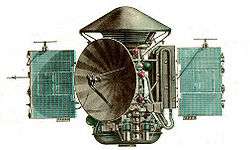Mars 2M No.522
| Mission type | Mars orbiter |
|---|---|
| Mission duration | Failed to orbit |
| Spacecraft properties | |
| Spacecraft type | 2M |
| Manufacturer | NPO Lavochkin |
| Launch mass | 4,850 kg (10,690 lb) |
| Start of mission | |
| Launch date | 2 April 1969, 10:33:00 UTC |
| Rocket | Proton-K/D s/n 233-01 |
| Launch site | Baikonur 81/24 |
Mars 2M No.522,[1] also known as Mars M-69 No.522 and sometimes identified by NASA as Mars 1969B, was a Soviet spacecraft which was lost in a launch failure in 1969.[2] It consisted of an orbiter. The spacecraft was intended to image the surface of Mars using three cameras, with images being encoded for transmission back to Earth as television signals. It also carried a radiometer, a series of spectrometers, and an instrument to detect water vapour in the atmosphere of Mars. It was one of two Mars 2M spacecraft, along with Mars 2M No.521, which was launched in 1969 as part of the Mars program. Neither launch was successful.[3]
Launch
Mars 2M No.522 was launched at 10:33:00 UTC on 2 April 1969 atop a Proton-K 8K78K carrier rocket with a Blok D upper stage, flying from Baikonur Cosmodrome Site 81/24.[1][4] One of the first stage engines caught fire almost immediately at liftoff. The remaining engines managed to compensate for about 30 seconds of flight, but the thrust section fire eventually resulted in loss of control.[5] The Proton pitched over and began flying horizontally before ground controllers sent a manual shutoff command. The vehicle nosedived into the ground just outside the launch complex 41 seconds after launch. Subsequent examination found that a missing drain plug allowed nitrogen tetroxide to leak out and start a fire.[2]
Post-accident effect
Following the crash of the Mars 2M No.522 launch vehicle, the wind spread toxic propellant back across the launch complex, which made the Baikonur Cosmodrome launch complex unusable until rain washed the toxic residuals away. Launch personnel were trapped and unable to leave the cosmodrome as a pool of spilled nitrogen tetroxide was blocking one of the entryways out, while other entryway was blocked by the still-intact second stage of the rocket. By the time this had happened, the alignment of Earth and Mars necessary to launch spacecraft had ended, and the Soviets were unable to launch any further Mars probes until 1971. It also resulted in delays to a number of Luna spacecraft scheduled for launch in 1969.[3]The accident left a deep impression on Soviet military personnel attending the launch and helped spur the development of next-generation ballistic missiles with safer solid propellants.
See also
References
- 1 2 McDowell, Jonathan. "Launch Log". Jonathan's Space Page. Retrieved 27 July 2010.
- 1 2 "Mars 1969B". NASA NSSDC. Retrieved 27 July 2010.
- 1 2 Wade, Mark. "Mars M-69". Encyclopedia Astronautica. Retrieved 27 July 2010.
- ↑ Krebs, Gunter. "Mars M69 #1, #2". Gunter's Space Page. Retrieved 27 July 2010.
- ↑ Wade, Mark. "Proton". Encyclopedia Astronautica. Retrieved 27 July 2010.
External links
- Cornell University's Mars Missions page
- The Soviet Mars program, Professor Chris Mihos, Case Western Reserve University


.jpg)
.jpg)